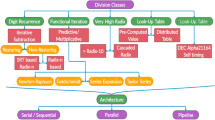Abstract
IT is a well-known fact that when a sinusoidal E.M.F. (of the form E0 sin wt) is available, it is a relatively simple matter to design an electrical system such that alternating currents or potential differences will occur in the system, having a frequency which is a whole multiple of the applied E.M.F., e.g. 2w, 3w, etc. For example, when the E.M.F. E0, sin wt is applied to a diode-rectifier, the current in the anode circuit will include a component of double frequency, i.e. 2w. This is therefore one method of frequency multiplication. Several other methods could easily be mentioned.
This is a preview of subscription content, access via your institution
Access options
Subscribe to this journal
Receive 51 print issues and online access
$199.00 per year
only $3.90 per issue
Buy this article
- Purchase on Springer Link
- Instant access to full article PDF
Prices may be subject to local taxes which are calculated during checkout
Similar content being viewed by others
Author information
Authors and Affiliations
Rights and permissions
About this article
Cite this article
VAN DER POL, B., VAN DER MARK, J. Frequency Demultiplication. Nature 120, 363–364 (1927). https://doi.org/10.1038/120363a0
Issue Date:
DOI: https://doi.org/10.1038/120363a0
This article is cited by
-
A generalized van der Pol nonlinear model of vortex-induced vibrations of bridge decks with multistability
Nonlinear Dynamics (2024)
-
Shortcut to synchronization in classical and quantum systems
Scientific Reports (2023)
-
The instantaneous phase difference between two parametric-excited cables with distinct parameters: characteristics and origination
Nonlinear Dynamics (2023)
-
Comparison of instantaneous phase differences between externally and parametrically excited suspended cable
Acta Mechanica (2023)
-
Farey tree and devil’s staircase of frequency-locked breathers in ultrafast lasers
Nature Communications (2022)
Comments
By submitting a comment you agree to abide by our Terms and Community Guidelines. If you find something abusive or that does not comply with our terms or guidelines please flag it as inappropriate.



